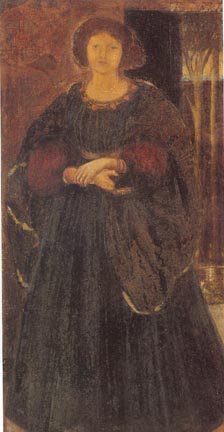[Victorian Web Home —> Visual Arts —> Artists —> Pre-Raphaelitism —> Sir Edward Burne-Jones —> Watercolors]

Belle et Blonde et Colorée
Sir Edward Coley Burne-Jones, Bt ARA (1833-1898)
c. 1860
Watercolor and gum arabic on paper
12 1/2 x 6 inches; 35 x 15 cm.
Provenance: John Miller of Liverpool; Thomas Agnew & Son, Manchester; Private collection
Peter Nahum, London, has most generously given its permission to use in the Victorian Web information, images, and text from its catalogues, and this generosity has led to the creation of hundreds and hundreds of the site's most valuable documents on painting, drawing, and sculpture. The copyright on text and images from their catalogues remains, of course, with the Peter Nahum. [GPL]
Comentary by John Christian
This picture is an exciting rediscovery. Burne-jones's career began officially in 1856 when he met Dante Gabriel Rossetti and began to work under his influence. For the first few years he devoted himself mainly to highly finished pen-and-ink drawings, although his mural in the Oxford Union and his earliest stained- glass cartoons also date from this period. In addition, he began to paint in watercolour, and in 1860 this medium took over as his primary means of expression. Belle et Blonde et Colorée sheds new light on Burne-Jones' working method at this early stage in his career as he explores the potential of various media with a youthful innocence and vigour. The dress is painted in Prussian blue watercolour in contrast to the model's hands, which are delicately heightened with oil paint. The artist has experimented with the light above the horizon which is seen through the open door; he has made the top right hand square translucent by treating the paper with linseed
In the summer ... I painted in watercolour 3 women
1. Belle et Blonde el Colorei
2. Sidonia von Bork
3. Clara von Bork
showed that it was one of the earliest of the series, and closely related to tile well-known pair of watercolours illustrating Wilhelm Meinhold's Sidonia the Sorceress, both dated 1860, which are in the Tate Gallery. The picture also appears in a list of recent works which Burne-Jones made in an early sketchbook (Victoria and Albert Museum; E.1-1955). This gives the further information that it was bought byj ohn Miller, a Liverpool merchant who was a staunch patron of the Pre-Raphaelites and whose daughter was married to Peter Paul Marshall, one of the partners in the Morris firm.
There is little doubt that the present picture is this long-lost work. It is only slightly smaller than the Von Bork watercolours and (as side-by-side examination has shown) very similar in technique. If anything, it would appear to be the earliest of the trio as the handling is more experimental, as if the artist had learnt lessons in painting it which he was able to apply with benefit to the 'Von Borks'. This would reflect the order in which the three watercolours, are listed in the Fitzwilliam work-record. There is also the evidence in an old hand written on the back on which it is possible to decipher the name ofJohn Miller and the words 'Russell Place.' This was Burne-jones's address from the autumn of 1858 to the autumn of 1861, a period which spans the painting of Belle et Blonde.
Conceptually the picture is what one would expect, an essay in the 'Venetian' style that so many of the Rossetti/Burne-jones circle adopted at this date. The details of the dress may have been taken from Cesare Vccellio's Abiti Antichi, an important source for the style from which Burne-jones made copies in the early sketch book in the Victoria & Albert Museum already mentioned. If the title has a literary origin, it has not been identified. It sounds as if it might have been suggested by Swinburne, who was on particulary close terms with Burne-jones in 1860. 'He had rooms very near us', Lady Burne-jones recalled in her Memorials, 'and we saw a great deal o fhim; sometimes twice or three times in a day he would come in, bringing his poems hot from his heart and certain of welcome and a hearing at any hour.'Swinburne was a passionate admirer of Meinhold, and this certainly influenced Burne-jones's choice of subject for the other two pictures he was working on that summer. Yet even if Belle et Blonde does have a literary source, this is obviously not central to an understanding of it in the sense that Meinhold's blood-curdling romance is central to an understanding of the Tate watercolours. In other words it is a more 'subjectless' or 'aesthetic' type of picture, and to that extent art-historically more advanced.
Bill Waters suggests in his introductory essay that the model may have been one of the Macdonald sisters. Agnes, the beauty of the family who was to marry Edward Poynter in 1866, does seem the most likely. As to the question of framing, the two Von Bork watercolours are still in the frames which Burne-Jones's father, a Birmingham frame-maker, made for them, and Belle et Blonde may once have been similarly framed. The original frame has been lost, but the one in which it is now presented is close to those of its contemporaries in the Tate.
May 1993
References
Waters, Bill. Burne-Jones -- A Quest for Love: Works by Sir Edward Burne-Jones Bt and Related Works by Contemporary Artists. London: Peter Nahum, 1993. Plate number 2.
Victorian
Web
Artists
Edward
Burne-Jones
Watercolors
Next
Last modified 12 June 2020